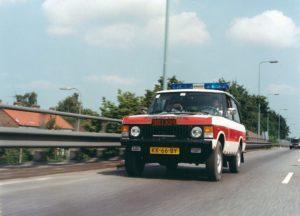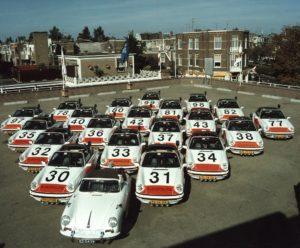The ideal tool
The exhibition 'Rijkspolitie Porsches' takes place in the Louwman Museum in The Hague from 8 July to 4 September. The museum shows thirteen different models and versions of the Porsches that the state police between 1962 and 1996 used. It is the first time that all models are exhibited together.
Porsche runs like a thread through the early years of the Traffic Police. The Porsche is suitable for the new task faced by the Traffic Police in the early 1960s: traffic monitoring. The number of cars has increased enormously in the 1950s, as has the number of road casualties on the approximately 500 kilometer of motorway. The government believes that measures are urgently needed. To improve supervision, more traffic experts and more efficient working methods are needed. For a test, police chief Lieutenant Kees Vogel can order one Porsche in Stuttgart. In November 1960, together with a colleague at Porsche in Stuttgart-Zuffenhausen, he received the first Porsche 356 B Cabriolet for the national police, raising 17.600 guilders. If the Minister of Justice gives the green light at the end of 1962 and the Special Road Tasks section becomes official, Vogel immediately orders twelve extra convertibles. These are the early years of a service that is later renamed Surveillance Auto Highways (SAS) - popularly known as Porsche Group.
The SAS is introducing a completely new method for the supervision of the motorways. The aim is to stand out and educate. Both the Porsches and the occupants with their white tunics and 'pot helmets' attract attention. But that is not the only reason why the Traffic Police choose Porsche. The cars radiate power, solidity and reliability. These qualities come in handy in 'overtaking surveillance', a way of working that was already practiced in the West German North Rhine-Westphalia. By driving about XNUMX kilometers faster than the rest of the traffic, the police seem to be everywhere. An open hood is a 'sacred must' in all weather conditions. Driving close is bought off with a round of cake for colleagues. The security guards are always immaculately dressed, regardless of the outside temperature. A shirt with short sleeves or your helmet? Unthinkable. If you are caught, you will be reprimanded by your commander.
Catching up traffic monitoring
Contact with road users is the most important calling card of the SAS. The highway is a new phenomenon and the road user is not yet used to it, let alone trained. Only from 1964 do CBR candidates take the exam outside built-up areas, but in large parts of the Netherlands a highway is still unique.
The Porsche is the ideal tool for the new task for which the Special Traffic Controls Section stands: the traffic monitoring that is taking hold. Thereby often corrective, but also verbalizing action is taken. With traffic jams along the still matrix board-less road network you can stand up straight in a Porsche, drive backwards for hours, regulate the traffic from the moving car and literally smell uncomfortable through the open hood. The Porsches not only contribute to a safer motorway network, but also ensure a more positive image of the police. If an agent with his Porsche puts someone aside, there is immediately awe. A servant who gets out of such a car has something to offer; he knows it. Agents are regularly warmly thanked when they write a ticket.
The air-cooled Porsches are almost indestructible; no car can do what you can do with that car. They are fast too. That is why in the first years only agents with a 'great sense of responsibility' are allowed to drive in Porsches, married and with at least one child. Chosen agents must also have driving experience, traffic insight and, of course, a good physical condition. An extensive psychological examination is also part of the selection procedure.
The crew has its 'own' car and pampers it to the bone. A service lasts two days; the thenders sleep at night in hotels along the highway. Part of the served Porsches is somewhat troubled via the Domains Service in the hands of private individuals. They then turn it into honorable civilian cars, although this exercise is usually unsuccessful.
Because despite all the efforts to rebuild the car into a regular sports car, the connoisseur immediately unmasks an ex AVD-911. The English right-hand doorman with a door mirror that is brought closer to the co-driver for a better rear view, is typical of a State Police Porsche. The dashboard is usually irreparably damaged by the extra switches, buttons and connection equipment. Also, the holes of the mobile antenna for the mobile radio on the left front screen, the call horn and the stop sign at the rear and the flashing light on the Targa bracket usually remain visible forever.
Discussions
The last ten 356 C Cabriolets are delivered to the police in 1966. A salient detail is that the production by Porsche will be resumed that year to build those 356s for the traffic service, while the production was stopped in April 1965 in favor of the 911. Then the first Porsches 911 come to Driebergen. They are 2.0 liter Targas, initially with a removable rear window. The traffic service grows over the years with the size of the Porsche engine: from the 2.2 and 2.4 models to the G-model with the 2.7 liter engine in 1974. After that the 1978 SC appears from 3.0 and in 1984 the 3.2 Carrera Targa with 231 pk.
The 964 Carrera 2 with an 3.6 liter engine appears in 1990, initially only as Targa, but later also as a Cabriolet. In addition to the 911 Targa and Cabriolet, the white mice also ride in the 912 Targa, 914 / 4, 914 / 6 and as a (failed) test in a water-cooled 924 with a highly exclusive T-roof.
But in the early nineties, discussions began in political The Hague about the usefulness of the fast service vehicle. A Porsche is no longer necessary or useful, politics believes.
Over the years, the task has shifted from traffic enforcement pur sang to detection in the broadest sense of the word. After all, crooks at all levels move across the highway sooner or later, is the philosophy. The space to transport criminals is more important than high top speeds. Since the arrival of matrix signs, the agents no longer have to drive back for a long time to secure the tail of a traffic jam, something the air-cooled engine was so suitable for. Moreover, Porsche has an expensive image; the Lubbers cabinet must cut back. Although practice shows that its successor, the Mercedes-Benz 190E, is barely cheaper below the line, the Mercedes-Benz is more politically marketable. The Alex 82, one of the last 964 Carrera 2 Cabriolets, drives straight into the Police Museum after its last service ride in 1996. The Dutch importer Pon has supplied the Traffic Police with a total of 507 Porsches, making it the largest fleet owner in Porsche's history to this day.
Porsche replacements
There are few European car brands with which the Traffic Police have not experimented. Car importers are therefore very keen to sell this branch of service cars. Because with some jealousy the competition sees the advantage that the Porsche importer gains with the police deployment of their brand. It is not so much about the numbers, but about the positive aura that hangs around the brand like a warm blanket. Potential Porsche substitutes are tested for fast, striking surveillance, although testing is done with little enthusiasm.
Models like the Alfa Romeo 2.0 Spider and Fiat 124 Abarth Spider from Italy, the British Triumph TR6 and the Citroën DS Chapron Cabriolet from France go as fast as they come. BMW expects to have a foothold in 1984 with the delivery of twenty 323i's from the E30 series. But despite technical adjustments - including to the tank and cooling - BMW literally and figuratively stranded.
The 3 Series is given the nickname 'Klote Karren Zonder Vooruitzicht' by the users, a free interpretation of the KK-ZV license plate series. In retrospect, some would like to admit that the BMWs had to be broken in favor of the Porsche. The Netherlands is shocked when media report that the AVD due to budget cuts Citroën 2CV6 as a surveillance car. The date is 1 April ...

A car that does make it to the traffic group is the Range Rover where the AVD orders a number of them in 1975 for the first time. The cars are used by the Basic Surveillance Group on the motorways, a club of police officers who are mainly concerned with checks on heavy goods traffic and accident handling. The vehicles drive in particular in the central Netherlands and have to replace the Hanomag vans in use there. This replacement is desperately needed. The German delivery van is excellent for handling a traffic accident, but it is life-threateningly slow for the surveillance task on the motorway.
That is why the BSG is looking for a vehicle that is strong enough to safely and quickly transport two police officers and that can also serve as a kind of mobile workplace. The car is equipped with, among other things, a first aid kit, floodlights, sedimentation equipment and photo equipment for recording accident situations. But that does not fill the luggage space. It also has equipment for removing obstacles, such as a winch, and a grinder for releasing trapped motorists. D
The eight-cylinder engine of the new four-wheel-driven Range Rover is so strong that even stranded trucks can be towed away with it. The Range Rover is after the 911 the most beloved car of the highway agents. An exact number of the Range Rovers in government service is unknown, but it is estimated that British Leyland Netherlands in Gouda has supplied around ninety to a hundred. Just like the Porsche, this Brit also stumbles over the costs. The Range Rover clears the field in favor of the Volkswagen Passat Variant in the early nineties. On LPG, because that is nice to defend economically and politically.

For a few years now car enthusiasts have noticed that police versions are part of the cultural heritage of the Netherlands. A lively search has emerged for original RP cars that - once found - are rebuilt to the state of back then.
In the meantime, many Porsches are known to assist them as if they could serve tomorrow, such as the beautiful cars from private collectors Chris Kruizinga and Jeroen Kuppers and from Porsche Centrum Gelderland and the Dutch Safety Institute. A small number of Range Rovers also survived the heavy government effort and resumed its original BMW engines from the KLPD. The owners even receive an exemption from the Ministry of Infrastructure and the Environment to have the blue flashing light on the vehicle, which is not allowed to work.
More than 1993 of these waivers are already in circulation. They are also allowed to drive with the striping and the inscription 'Rijkspolitie' because, unlike the current Dumbar striping, this police trim is not copyrighted and the Korps Rijkspolitie no longer exists after a reorganization in XNUMX. The former police vehicles are welcome guests at car events and parties and parties. Everyone wants to get behind the wheel for a while, because nostalgia is fun.

